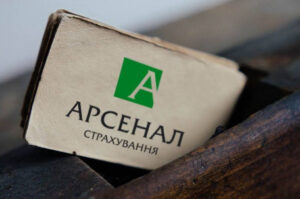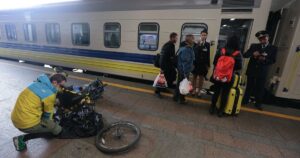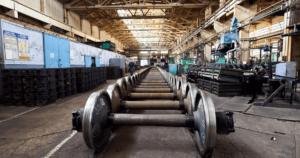
According to the results of its operations in January-September of this year, Kryvyi Rih Iron Ore Plant (KZRK) increased its net loss by 3.2 times compared to the same period last year, to UAH 1 billion 487.217 million.
According to KZRK’s interim report, available to Interfax-Ukraine, net income for this period decreased by 41.6% to UAH 1 billion 601.822 million.
Undistributed profit at the end of September 2025 amounted to UAH 2 billion 8.823 million.
According to the annual report, KZRK ended 2024 with a net loss of UAH 2 billion 14.015 million, while in 2023 it amounted to UAH 63.411 million. Net income in 2024 amounted to UAH 3 billion 443.081 million, and in 2023 – UAH 5 billion 577.923 million.
In 2024, the plant produced 1.693 million tons of raw ore, with 1.370 million tons of commercial ore. The plan for 2025 is 4.385 million tons of raw ore and 3.6 million tons of commercial ore.
As reported, on May 23, 2025, Tviy Energosupplach (Kyiv) applied to the Commercial Court of Dnipropetrovsk Region to initiate bankruptcy proceedings against KZRK due to its debt for electricity consumption. The
Commercial Court of Dnipropetrovsk Region ruled to open bankruptcy proceedings against KZRK on June 9 of this year.
KZRK specializes in underground iron ore mining. It consists of four mines: Pokrovska (formerly Zhovtneva), Kryvorizka (Batkivshchyna), Kozatska (formerly Hvardiyiska), and Ternivska (formerly the Ordzhonikidze
Ore Management, then named after Lenin).
According to NDU data for the first quarter of 2025, the main shareholder of KZRK is Starmill Limited (Cyprus), which owns 99.8812% of its shares. Operational control of the plant prior to the introduction of bankruptcy proceedings was exercised by the Privat Group.
In May 2023, Ukraine imposed sanctions against dozens of foreign companies linked to Russian individuals who own large assets in Ukraine, including KZRK. Some of these assets had already been seized, but the sanctions paved the way for their confiscation. The relevant presidential decree No. 279 of May 12 was published on the website of the head of state. In particular, the list of legal entities included Starmill Limited, which owns 99.89% of KZRK under the operational control of the Privat Group.
The authorized capital of the enterprise is UAH 1 billion 991.233 million.

Insurance company ARX (Kyiv) made payments totaling UAH 50.831 million in January-September 2025 under military risk insurance, according to information from the insurer.
Payments were made for 104 insured events. Of these, 97 related to motor vehicles insured against damage or destruction as a result of damage or total loss of the vehicle from missiles and drones, including damage from their debris, or debris from structures and trees caused by the fall of such debris.
In addition, seven cases involved payments under insurance contracts for buildings and structures with finishes and communications, integral property complexes, as well as equipment, office equipment, and inventory damaged as a result of rocket and/or drone attacks, for a total amount of over UAH 40 million.
ARX is part of the international insurance holding company Fairfax Financial Holdings Ltd.

On June 10, 2025, during a massive shelling of Kyiv, the business center building was damaged by debris from an enemy Shahed-type UAV.
The facade, walls, windows, interior partitions, ceiling, floor, and doors were significantly damaged. Engineering and communication systems were also affected: ventilation, heating, power supply, lighting, fire extinguishing, as well as the roof, interior decoration, furniture, and office equipment.
The building was insured against military risks under a co-insurance agreement between three companies: ARSENAL INSURANCE, UNIQA, and TAS. The insurance coverage included the building with all premises, finishes, glass elements, and office equipment. According to the results of an expert assessment, the amount of insurance compensation amounted to more than UAH 12 million. The amount of the payment was determined based on the cost of restoration work, excluding depreciation.
On September 22, 2025, ARSENAL INSURANCE received the last necessary documents, and on September 26, it made its share of the payment — UAH 4,112,237. Thus, only four days passed from the moment the documents were collected to the actual transfer of funds to the client.
“Cases involving military risks are a special category of settlements that require maximum speed and objectivity. Our task is to provide the client with financial support for the rapid restoration of business processes, even in such extraordinary circumstances,” said ARSENAL INSURANCE.
ARSENAL INSURANCE expresses its gratitude to its co-insurance partners, UNIQA and TAS, for their constructive cooperation and effective interaction in the process of settling this complex insurance case.
At the same time, during the settlement process, on August 28, 2025, the same business center was damaged by shelling for the second time. The blast wave and debris again caused damage to the building. The settlement of the second insurance case is currently underway, for which a payment will also be made.

The global gap in cyber risk protection is $0.9 trillion, with insured losses covering only 1% of economic losses from cyber incidents. This is stated in the report “Strengthening Cybersecurity: Key Indicators for Policymakers” prepared by the Zurich Insurance Group together with the Cyber Threat Alliance and the CyberGree Institute and published on the Zurich website.
It calls for the introduction of standardized national cybersecurity indicators.
As noted, the report relies on reliable quantitative data to improve standards and best practices. Although organizations such as ENISA and CISA set frameworks at the corporate level, national indicators for policy-making are virtually non-existent.
Zurich’s new report presents six key indicators and an institutional framework for governments to help clarify national cyber risks, strengthen resilience, and ensure informed policy decisions. Specifically, the creation of National Cyber Statistics Offices—specialized agencies to collect these metrics—will ensure consistent incident reporting, threat and resilience tracking, publication of key analyses, and assessment of security regulation effectiveness. These offices could also support a supranational body for aggregating results, enabling deeper global comparison and understanding of evolving threats.

Rail passenger transport in Ukraine, which is currently monopolized by Ukrzaliznytsia, requires the introduction of a Public Service Obligations (PSO) mechanism – predictable compensation for subsidized transport, according to Yulia Sirko, first deputy chair of the parliamentary committee on transport and infrastructure (Holos faction).
“There are many passengers who pay either 0 or 50%, for example, as UBD and so on. We have a number of beneficiaries who use transport, including rail, and this is, de facto, not compensated by the state or local authorities,“ she said at an expert discussion held by the Center for Transportation Strategies on ”Rail Freight Tariffs in 2025-2026” on Wednesday.
According to her, without the implementation of a set of PSO laws, Ukrzaliznytsia will be forced to constantly turn to the government and the Verkhovna Rada for funding for unprofitable passenger transportation.
Sirk added that PSOs will make this area transparent and recalled that Ukraine has committed to implementing these standards as part of the Ukraine Facility program.
“Unfortunately, passenger transportation continues to be unprofitable. This requires Ukrzaliznytsia to optimize all processes, optimize its operational activities, understand capital investments for 3-5 years, and understand unprofitability for 3-5 years,” the first deputy chair of the relevant parliamentary committee also noted.
As reported, Ukrzaliznytsia’s operating loss from intercity and international passenger transportation last year amounted to UAH 8.81 billion with revenues of UAH 10.67 billion, while from suburban transportation it amounted to UAH 9.31 billion with revenues of UAH 0.52 billion.
The Verkhovna Rada recently amended the state budget for 2025 and allocated UAH 8 billion in bank income tax to Ukrzaliznytsia, which should have gone to the Kyiv budget. In May this year, Ukrzaliznytsia also received UAH 4.3 billion from the budget to support passenger transportation during the war.

Losses in the railcar repair sector due to the situation on the rail transport market, in particular the surplus of railcars, may reach UAH 600 million in 2025, and more business involvement is needed to find alternatives, said Yevhen Shramko, head of the Repair and Production Division at Ukrzaliznytsia (UZ).
“At a meeting (with businesses and investors in August, initiated by UZ – IF-U), we discussed the forecast for the car fleet, which, unfortunately, is disappointing. New railcars are hardly being built due to the surplus. All this leads to the fact that, according to our forecasts, the losses of the railcar repair division will reach UAH 600 million by the end of 2025,” he said in an interview with Interfax-Ukraine.
The UZ representative recalled that transport volumes had decreased by 40%, and transport by the state-owned company’s railcars had decreased even more, by 58%. As a result, the volume of repairs, almost 70% of the cost of which is personnel expenses, also decreased by 55%.
Shramko noted that given this situation and the worsening forecast for the coming year, the company decided to go public and attract international partners, consultants who can help obtain grants or other funding to transform car repair enterprises without losing personnel and potential, as well as to attract as much business as possible for more efficient use of production capacities, which are currently redundant.
Shramko clarified that after the meeting, all participants were sent a questionnaire to obtain information about the real needs of the market, in particular, what facilities are needed, taking into account their location and infrastructure (electricity, gas, water supply).
“We only received 13 responses. To be honest, this is not enough. So we will continue to work with businesses, associations, and investors,” said the head of the department.
According to him, this is the first step towards transparent optimization and reorganization of excess production capacities that generate losses for Ukrzaliznytsia. Next, a list of facilities and proposals for international and local investors will be prepared.
“We are considering various options: leasing, public-private partnerships, and repurposing, and we want all of them to be implemented on a competitive basis,” Shramko emphasized.
He added that next year, during the proper gradual reorganization, it is planned to tackle the locomotive repair sector, where the company also has significant capacity.
“Given the current situation in the industry and the dynamics of transportation, a return to last year’s volumes seems unlikely at this point, according to our forecasts,” the director of the division emphasized.
Ukrzaliznytsia’s Repair and Production Division is responsible for the repair, maintenance, modernization, and manufacture of railcars, locomotives, and electric trains. It produces critical spare parts, reinforced concrete sleepers, technical equipment, etc. It has 11 enterprises, some of which are branches, and some are private joint-stock companies.
As reported, the volume of freight transportation by rail in Ukraine decreased from 180 billion t*km in 2021 to 113 billion t*km in 2024, and transportation by the company’s railcars decreased from 1,206,000 to 727,000. This year, these figures are expected to decrease to 106 billion t*km and 481 thousand, respectively.
These conditions led to a decrease in the volume of car repairs from 31,750 in 2021 (of which 20,150 were Ukrzaliznytsia cars) to 24,230 in 2024 (12,480), and this year a further reduction to 14,040 (3,960) is expected.